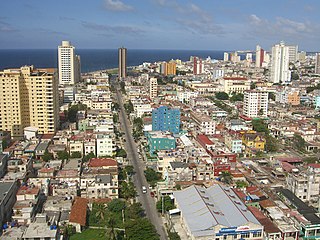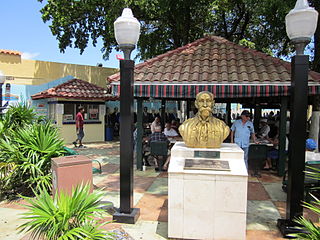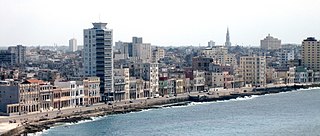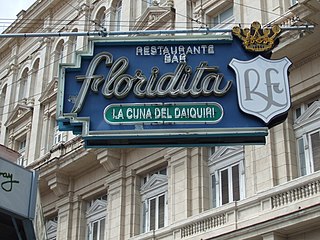
Havana is the capital and largest city of Cuba. The heart of the La Habana Province, Havana is the country's main port and commercial center. It is the most populous city, the largest by area, and the second largest metropolitan area in the Caribbean region. The population in 2002 was 2,137,847 inhabitants, and its area is 728.26 km2 (281.18 sq mi) for the capital city side and 8,475.57 km2 for the metropolitan zone.

Little Havana is a neighborhood of Miami, Florida, United States. Home to many Cuban exiles, as well as many immigrants from Central and South America, Little Havana is named after Havana, the capital and largest city in Cuba.

Vedado is a central business district and urban neighborhood in the city of Havana, Cuba. Bordered on the east by Calzada de Infanta and Central Havana, and on the west by the Alemendares River and Miramar / Playa district, Vedado is a more modern part of the city than the areas to the east, developed in the first half of the 20th century, during the Republic period. In 2016 it was described by one commentator as the city's "most affluent" section. The main street running east to west is Calle 23, also known as "La Rampa". The northern edge of the district is the waterfront seawall known as the Malecón, a famous and popular place for social gatherings in the city. The area popularly referred to as 'Vedado' consists of the wards of Vedado, Rampa, Vedado-Malecón and Carmelo, all in the municipality of Plaza de la Revolución.

Miramar is a residential district of the municipality of Playa, in the city of Havana.

The Malecón is a broad esplanade, roadway, and seawall that stretches for 8 km along the coast in Havana, Cuba, from the mouth of Havana Harbor in Old Havana, along the north side of the Centro Habana neighborhood and the Vedado neighborhood, ending at the mouth of the Almendares.

The Museum of Decorative Arts, at 17th and E streets in the Vedado district of Havana, Cuba is a decorative arts museum in the former residence of the María Luisa Gómez-Mena viuda de Cagiga, Countess of Revilla de Camargo, sister of José Gómez-Mena Vila, the owner of the Manzana de Gómez. It was designed in Paris by architects P. Virad and M. Destuque, inspired in French Renaissance and was built between 1924 and 1927 in a neo-classical style.

The Gran Hotel Manzana Kempinski La Habana is a luxury hotel in Havana, Cuba. It is located in the historic Manzana de Gómez building, an early-20th-century building that was Cuba's first shopping mall. The Kempinski Hotel chain, belongs to the oldest hotel groups in Europe, Kempinski Aktiengesellschaft.

Floridita or El Floridita is a historic fish restaurant and cocktail bar in the older part of Havana, Cuba. It lies at the end of Calle Obispo, across Monserrate Street from the National Museum of Fine Arts of Havana. The establishment is famous for its daiquiris and for having been one of the favourite hangouts of Ernest Hemingway in Havana. The bar now boasts a life size bronze statue of Ernest Hemingway positioned in his favourite spot at the end of the bar. On a small plaque hanging in El Floridita, hangs Hemingway's signed quote: "My mojito in the Bodeguita del Medio and my daiquiri in the Floridita".

The Hotel Ambos Mundos is a hotel in Havana, Cuba. Built with a square form with five floors, it has an eclectic set of characteristics of 20th-century style architecture. It was built in 1924 on a site that previously had been occupied by an old family house on the corner of Calle Obispo and Mercaderes in Old Havana. It is a frequent tourist destination because it was home to the popular writer Ernest Hemingway for seven years in the 1930s.

The University of Havana is a public university located in the Vedado district of Havana, the capital of Cuba. Founded on 5 January 1728, the university is the oldest in Cuba, and one of the first to be founded in the Americas. Originally a religious institution, today the university has 15 faculties (colleges) at its Havana campus and distance learning centers throughout Cuba.

The Napoleon Museum in Havana, Cuba houses one of the most important collections from the 18th and 19th centuries preserved in the Western hemisphere. The museum is on San Miguel Street, between Ronda and Mazón, on one side of the University of Havana.

Fayad Jamís (1930–1988) was a Cuban poet, painter, designer, journalist and translator. He was born in Zacatecas, Mexico to a Lebanese-Cuban father and a Mexican mother. Moving to Cuba at the age of six, Jamis trained at the San Alexandro Academy before gaining renown as an abstract painter. He was a member of the modernist group of Cuban painters known as "Las Once".

Cayo Hueso is a consejo popular (ward) in the municipality of Centro Habana, Havana, Cuba. A traditionally working-class neighborhood populated by Afro-Cubans, it is known for its many cultural landmarks such as the Callejón de Hamel, the Fragua Martiana Museum and the Parque de los Mártires Universitarios.

The López Serrano Building was the tallest residential building in Cuba until the construction of the FOCSA in 1956. Designed by the architect Ricardo Mira in 1929, who in 1941 who also designed La Moderna Poesia bookstore on Obispo Street for the same owner, it is often compared to the Bacardi Building in Old Havana built two years before the López Serrano Building because of their similarity in massing and central tower. The congressman, senator, and presidential candidate Eduardo Chibás was living on the fourteenth-floor penthouse when he committed suicide in August 1951 on the air at CMQ Radio Station.

The Iglesia del Espíritu Santo is a colonial church at #702 Calle Cuba in Old Havana, Havana, Cuba, was built in 1635 on the corner of the corner of Calles Cuba and Acosta. The Espíritu Santo contains some notable paintings including a seated, post-crucifixion Christ on the right wall, and catacombs. It is considered one of the oldest temples in Havana. Free blacks, already numerous, devoted the church to the Holy Spirit in 1638.

The Iglesia del Santo Cristo del Buen Viaje is located in Old Havana, Havana on Calle Cristo between Calles Lamparilla y Teniente Rey. Built at a time in which transatlantic crossings were risky, it acquired popularity during colonial times as a temple dedicated to travelers and navigators. Travelers and especially sailors would visit before leaving on a journey, and to pay their respects upon arriving back on land. Later during Cuba's republican era, the devotion to Saint Rita was added to the church.

Hospital de San Lázaro was a hospital in the city of Havana, Cuba. It dates back to the 17th century, when it served as headquarters for some huts built near the Caleta de Juan Guillén, then known as Caleta de San Lázaro, in an area about a mile outside the city walls.

Barrio de San Lázaro is one of the first neighbourhoods in Havana, Cuba. It initially occupied the area bounded by Calle Infanta to the west, Calle Zanja to the south, Calle Belascoáin to the east, and the Gulf of Mexico to the north, forming the western edge of Centro Habana. According to the 1855 Ordenanzas Municipales of the city of Havana, Barrio San Lázaro was the Tercer Distrito and was Barrio No. 8.

The Plaza del Vapor was a covered market in Havana, it was completed in 1835. Its name derives from its builder Francisco Martí who became later the impresario of the Tacón Theatre and who had a monopoly of fish trade in the city. Martí had a painting placed against a wall from a bar of the ship El Neptuno, the first vapor that made regular round trips between Havana and Matanzas. "It was the image of that ship that ended up naming the building." From the Plaza del Vapor, Martí sold 50% of all the lottery tickets. in Cuba.

Arab Cubans refers to Arab immigrants and their descendants in Cuba and the Cuban diaspora. Most of Cuba's Arab community come from Syrian, Lebanese or Palestinian backgrounds.
























